SNOS534J February 2001 – November 2016 LMV712-N , LMV712-N-Q1
PRODUCTION DATA.
- 1 Features
- 2 Applications
- 3 Description
- 4 Revision History
- 5 Pin Configuration and Functions
- 6 Specifications
- 7 Detailed Description
- 8 Application and Implementation
- 9 Power Supply Recommendations
- 10Layout
- 11Device and Documentation Support
- 12Mechanical, Packaging, and Orderable Information
Package Options
Mechanical Data (Package|Pins)
Thermal pad, mechanical data (Package|Pins)
Orderable Information
6 Specifications
6.1 Absolute Maximum Ratings
over operating free-air temperature range (unless otherwise noted)(1)(2)| MIN | MAX | UNIT | ||
|---|---|---|---|---|
| Differential input voltage | ±Supply voltage | |||
| Voltage at input or output pin | (V+) + 0.4 | (V–) – 0.4 | V | |
| Supply voltage (V+ – V–) | 6 | V | ||
| V+, V– | Output short circuit | See(3) | ||
| Current at input pin | ±10 | mA | ||
| Current at output pin | ±50 | mA | ||
| TJMAX | Junction temperature(4) | 150 | °C | |
| Tstg | Storage temperature | –65 | 150 | °C |
(1) Absolute Maximum Ratings indicate limits beyond which damage to the device may occur. Operating Ratings indicate conditions for which the device is intended to be functional, but specific performance is not ensured. For ensured specifications and the test conditions, see the Electrical Characteristics.
(2) If Military/Aerospace specified devices are required, please contact the Texas Instruments Sales Office / Distributors for availability and specifications.
(3) Shorting circuit output to either V+ or V− adversely affects reliability.
(4) The maximum power dissipation is a function of TJ(MAX) and RθJA. The maximum allowable power dissipation at any ambient temperature is PD = (TJ(MAX) – TA) / RθJA. All numbers apply for packages soldered directly onto a PCB.
6.2 ESD Ratings
| VALUE | UNIT | |||
|---|---|---|---|---|
| V(ESD) | Electrostatic discharge | Human-body model (HBM), per ANSI/ESDA/JEDEC JS-001(1) | ±1500 | V |
| Charged-device model (CDM), per JEDEC specification JESD22-C101(2) | ±150 | |||
(1) JEDEC document JEP155 states that 500-V HBM allows safe manufacturing with a standard ESD control process.
(2) JEDEC document JEP157 states that 250-V CDM allows safe manufacturing with a standard ESD control process.
6.3 Recommended Operating Conditions
over operating free-air temperature range (unless otherwise noted)| MIN | MAX | UNIT | ||
|---|---|---|---|---|
| Supply voltage | 2.7 | 5.5 | V | |
| Operating temperature | LMV712 | –40 | 85 | °C |
| LMV712-Q1 | –40 | 125 | °C | |
6.4 Thermal Information
| THERMAL METRIC(1) | LMV712-N, LMV712-N-Q1 | UNIT | |||
|---|---|---|---|---|---|
| YPA (DSBGA) | NGY (WSON) | DGS (VSSOP) | |||
| 10 PINS | 10 PINS | 10 PINS | |||
| RθJA | Junction-to-ambient thermal resistance | 84.1 | 70 | 176.8 | °C/W |
| RθJC(top) | Junction-to-case (top) thermal resistance | 0.6 | 74.7 | 67.5 | °C/W |
| RθJB | Junction-to-board thermal resistance | 21.4 | 43.7 | 97.2 | °C/W |
| ψJT | Junction-to-top characterization parameter | 2.2 | 2 | 9.4 | °C/W |
| ψJB | Junction-to-board characterization parameter | 21.3 | 43.7 | 95.8 | °C/W |
| RθJC(bot) | Junction-to-case (bottom) thermal resistance | — | 11.8 | — | °C/W |
(1) For more information about traditional and new thermal metrics, see the Semiconductor and IC Package Thermal Metrics application report.
6.5 Electrical Characteristics – 2.7 V
All limits ensured for V+ = 2.7 V, V − = 0 V, VCM = 1.35 V, TA = 25°C, and RL > 1 mΩ (unless otherwise noted)| PARAMETER | TEST CONDITIONS | MIN(1) | TYP(2) | MAX(1) | UNIT | ||
|---|---|---|---|---|---|---|---|
| VOS | Input offset voltage (WSON and VSSOP) |
VCM = 0.85 V and VCM = 1.85 V |
TA = 25°C | 0.4 | 3 | mV | |
| −40°C ≤ TJ ≤ 85°C (LMV712) or −40°C ≤ TJ ≤ 125°C (LMV712-Q1) |
3.2 | ||||||
| Input offset voltage (DSBGA only) |
VCM = 0.85 V and VCM = 1.85 V |
TA = 25°C | 3 | 7 | |||
| −40°C ≤ TJ ≤ 85°C (LMV712) or −40°C ≤ TJ ≤ 125°C (LMV712-Q1) |
9 | ||||||
| IB | Input bias current | LMV712 | TA = 25°C | 5.5 | 115 | pA | |
| −40°C ≤ TJ ≤ 85°C | 130 | ||||||
| LMV712-Q1 | TA = 25°C | 5.5 | |||||
| −40°C ≤ TJ ≤ 125°C | 3740 | ||||||
| CMRR | Common mode rejection ratio | 0 V ≤ VCM ≤ 2.7 V | TA = 25°C | 50 | 75 | dB | |
| −40°C ≤ TJ ≤ 85°C (LMV712) or −40°C ≤ TJ ≤ 125°C (LMV712-Q1) |
45 | ||||||
| PSRR | Power supply rejection ratio | 2.7 V ≤ V+ ≤ 5 V, VCM = 0.85 V |
TA = 25°C | 70 | 90 | dB | |
| −40°C ≤ TJ ≤ 85°C (LMV712) or −40°C ≤ TJ ≤ 125°C (LMV712-Q1) |
68 | ||||||
| 2.7 V ≤ V+ ≤ 5 V, VCM = 1.85 V |
TA = 25°C | 70 | 90 | ||||
| −40°C ≤ TJ ≤ 85°C (LMV712) or −40°C ≤ TJ ≤ 125°C (LMV712-Q1) |
68 | ||||||
| CMVR | Common mode voltage | For CMRR ≥ 50 dB | V- | −0.2 | −0.3 | V | |
| V+ | 3 | 2.9 | |||||
| ISC | Output short circuit current | Sourcing VO = 0 V |
TA = 25°C | 15 | 25 | mA | |
| −40°C ≤ TJ ≤ 85°C (LMV712) or −40°C ≤ TJ ≤ 125°C (LMV712-Q1) |
12 | ||||||
| Sinking VO = 2.7 V |
TA = 25°C | 25 | 50 | ||||
| −40°C ≤ TJ ≤ 85°C (LMV712) or −40°C ≤ TJ ≤ 125°C (LMV712-Q1) |
22 | ||||||
| VO | Output swing | RL = 10 kΩ to 1.35 V |
TA = 25°C | 2.62 | 2.68 | V | |
| −40°C ≤ TJ ≤ 85°C (LMV712) or −40°C ≤ TJ ≤ 125°C (LMV712-Q1) |
2.6 | ||||||
| TA = 25°C | 0.01 | 0.12 | |||||
| −40°C ≤ TJ ≤ 85°C (LMV712) or −40°C ≤ TJ ≤ 125°C (LMV712-Q1) |
0.15 | ||||||
| RL = 600 Ω to 1.35 V |
TA = 25°C | 2.52 | 2.55 | ||||
| −40°C ≤ TJ ≤ 85°C (LMV712) or −40°C ≤ TJ ≤ 125°C (LMV712-Q1) |
2.5 | ||||||
| TA = 25°C | 0.05 | 0.23 | |||||
| −40°C ≤ TJ ≤ 85°C (LMV712) or −40°C ≤ TJ ≤ 125°C (LMV712-Q1) |
0.3 | ||||||
| VO(SD) | Output voltage in shutdown | 10 | 200 | mV | |||
| IS | Supply current per channel | On mode | TA = 25°C | 1.22 | 1.7 | mA | |
| −40°C ≤ TJ ≤ 85°C (LMV712) or −40°C ≤ TJ ≤ 125°C (LMV712-Q1) |
1.9 | ||||||
| Shutdown mode | TA = 25°C | 0.12 | 1.5 | µA | |||
| −40°C ≤ TJ ≤ 85°C (LMV712) or −40°C ≤ TJ ≤ 125°C (LMV712-Q1) |
2 | ||||||
| AVOL | Large signal voltage gain | LMV712 Sourcing RL = 10 kΩ VO = 1.35 V to 2.3 V |
TA = 25°C | 80 | 115 | dB | |
| −40°C ≤ TJ ≤ 85°C | 76 | ||||||
| LMV712-Q1 | TA = 25°C | 115 | |||||
| −40°C ≤ TJ ≤ 125°C | 69 | ||||||
| LMV712 Sinking RL = 10 kΩ VO = 0.4 V to 1.35 V |
TA = 25°C | 80 | 113 | ||||
| −40°C ≤ TJ ≤ 85°C | 76 | ||||||
| LMV712-Q1 | TA = 25°C | 113 | |||||
| −40°C ≤ TJ ≤ 125°C | 69 | ||||||
| LMV712 Sourcing RL = 600 Ω VO = 1.35 V to 2.2 V |
TA = 25°C | 80 | 97 | ||||
| −40°C ≤ TJ ≤ 85°C | 76 | ||||||
| LMV712-Q1 | TA = 25°C | 97 | |||||
| −40°C ≤ TJ ≤ 125°C | 64 | ||||||
| LMV712 Sinking RL = 600 Ω VO = 0.5 V to 1.35 V |
TA = 25°C | 80 | 100 | ||||
| −40°C ≤ TJ ≤ 85°C | 76 | ||||||
| LMV712-Q1 | TA = 25°C | 100 | |||||
| −40°C ≤ TJ ≤ 125°C | 62 | ||||||
| VSD | Shutdown pin voltage | On mode | 2.4 | 2.0 | V | ||
| Shutdown mode | 1 | 0.8 | |||||
| GBWP | Gain-bandwidth product | 5 | MHz | ||||
| SR | Slew rate(3) | 5 | V/µs | ||||
| φm | Phase margin | 60 | ° | ||||
| en | Input referred voltage noise | f = 1 kHz | 20 | nV/√Hz | |||
| TON | Turnon time from shutdown | TA = 25°C | 2.2 | 4 | µs | ||
| −40°C ≤ TJ ≤ 85°C (LMV712) or −40°C ≤ TJ ≤ 125°C (LMV712-Q1) |
4.6 | ||||||
| DSBGA turnon time from shutdown | TA = 25°C | 6 | |||||
| −40°C ≤ TJ ≤ 85°C (LMV712) or −40°C ≤ TJ ≤ 125°C (LMV712-Q1) |
8 | ||||||
(1) All limits are ensured by testing or statistical analysis.
(2) Typical values represent the most likely parametric norm as determined at the time of characterization. Actual typical values may vary over time and also depend on the application and configuration. The typical values are not tested and are not ensured on shipped production material.
(3) Number specified is the slower of the positive and negative slew rates.
6.6 Electrical Characteristics – 5 V
All limits ensured for V+ = 5 V, V − = 0 V, VCM = 2.5 V, TA = 25°C, and RL > 1 mΩ (unless otherwise noted)| PARAMETER | TEST CONDITIONS | MIN(2) | TYP(1) | MAX(2) | UNIT | ||
|---|---|---|---|---|---|---|---|
| VOS | Input offset voltage (WSON and VSSOP) |
VCM = 0.85 V and VCM = 1.85 V |
TA = 25°C | 0.4 | 3 | mV | |
| −40°C ≤ TJ ≤ 85°C (LMV712) or −40°C ≤ TJ ≤ 125°C (LMV712-Q1) |
3.2 | ||||||
| Input offset voltage (DSBGA only) |
VCM = 0.85 V and VCM = 1.85 V |
TA = 25°C | 3 | 7 | |||
| −40°C ≤ TJ ≤ 85°C (LMV712) or −40°C ≤ TJ ≤ 125°C (LMV712-Q1) |
9 | ||||||
| IB | Input bias current | LMV712 | TA = 25°C | 5.5 | 115 | pA | |
| −40°C ≤ TJ ≤ 85°C | 130 | ||||||
| LMV712-Q1 | −40°C ≤ TJ ≤ 125°C | 3600 | |||||
| CMRR | Common mode rejection ratio | 0 V ≤ VCM ≤ 5 V | TA = 25°C | 50 | 80 | dB | |
| −40°C ≤ TJ ≤ 85°C (LMV712) or −40°C ≤ TJ ≤ 125°C (LMV712-Q1) |
45 | ||||||
| PSRR | Power supply rejection ratio | 2.7 V ≤ V+ ≤ 5 V, VCM = 0.85 V |
TA = 25°C | 70 | 90 | dB | |
| −40°C ≤ TJ ≤ 85°C (LMV712) or −40°C ≤ TJ ≤ 125°C (LMV712-Q1) |
68 | ||||||
| 2.7 V ≤ V+ ≤ 5 V, VCM = 1.85 V |
TA = 25°C | 70 | 90 | ||||
| −40°C ≤ TJ ≤ 85°C (LMV712) or −40°C ≤ TJ ≤ 125°C (LMV712-Q1) |
68 | ||||||
| CMVR | Common mode voltage | For CMRR ≥ 50 dB | V- | −0.2 | −0.3 | V | |
| V+ | 5.3 | 5.2 | |||||
| ISC | Output short circuit current | Sourcing VO = 0 V |
TA = 25°C | 20 | 35 | mA | |
| −40°C ≤ TJ ≤ 85°C (LMV712) or −40°C ≤ TJ ≤ 125°C (LMV712-Q1) |
18 | ||||||
| Sinking VO = 5 V |
TA = 25°C | 25 | 50 | ||||
| −40°C ≤ TJ ≤ 85°C (LMV712) or −40°C ≤ TJ ≤ 125°C (LMV712-Q1) |
21 | ||||||
| VO | Output swing | RL = 10 kΩ to 2.5 V | TA = 25°C | 4.92 | 4.98 | V | |
| −40°C ≤ TJ ≤ 85°C (LMV712) or −40°C ≤ TJ ≤ 125°C (LMV712-Q1) |
4.9 | ||||||
| TA = 25°C | 0.01 | 0.12 | |||||
| −40°C ≤ TJ ≤ 85°C (LMV712) or −40°C ≤ TJ ≤ 125°C (LMV712-Q1) |
0.15 | ||||||
| RL = 600 Ω to 2.5 V | TA = 25°C | 4.82 | 4.85 | ||||
| −40°C ≤ TJ ≤ 85°C (LMV712) or −40°C ≤ TJ ≤ 125°C (LMV712-Q1) |
4.8 | ||||||
| TA = 25°C | 0.05 | 0.23 | |||||
| −40°C ≤ TJ ≤ 85°C (LMV712) or −40°C ≤ TJ ≤ 125°C (LMV712-Q1) |
0.3 | ||||||
| VO(SD) | Output voltage in shutdown | 10 | 200 | mV | |||
| IS | Supply current per channel | On mode | TA = 25°C | 1.17 | 1.7 | mA | |
| −40°C ≤ TJ ≤ 85°C (LMV712) or −40°C ≤ TJ ≤ 125°C (LMV712-Q1) |
1.9 | ||||||
| Shutdown mode | TA = 25°C | 0.12 | 1.5 | µA | |||
| −40°C ≤ TJ ≤ 85°C (LMV712) or −40°C ≤ TJ ≤ 125°C (LMV712-Q1) |
2 | ||||||
| AVOL | Large signal voltage gain | LMV712 Sourcing RL = 10 kΩ VO = 2.5 V to 4.6 V |
TA = 25°C | 80 | 130 | dB | |
| −40°C ≤ TJ ≤ 85°C | 76 | ||||||
| LMV712-Q1 | TA = 25°C | 130 | |||||
| −40°C ≤ TJ ≤ 125°C | 69 | ||||||
| LMV712 Sinking RL = 10 kΩ VO = 0.4 V to 2.5 V |
TA = 25°C | 80 | 130 | ||||
| −40°C ≤ TJ ≤ 85°C | 76 | ||||||
| LMV712-Q1 | TA = 25°C | 130 | |||||
| −40°C ≤ TJ ≤ 125°C | 69 | ||||||
| LMV712 Sourcing RL = 600 Ω VO = 2.5 V to 4.6 V |
TA = 25°C | 80 | 110 | ||||
| −40°C ≤ TJ ≤ 85°C | 76 | ||||||
| LMV712-Q1 | TA = 25°C | 110 | |||||
| −40°C ≤ TJ ≤ 125°C | 69 | ||||||
| LMV712 Sinking RL = 600 Ω VO = 0.4 V to 2.5 V |
TA = 25°C | 80 | 107 | ||||
| −40°C ≤ TJ ≤ 85°C | 76 | ||||||
| LMV712-Q1 | TA = 25°C | 107 | |||||
| −40°C ≤ TJ ≤ 125°C | 69 | ||||||
| VSD | Shutdown pin voltage | On mode | 4.5 | 3.5 | V | ||
| Shutdown mode | 1.5 | 0.8 | |||||
| GBWP | Gain-bandwidth product | 5 | MHz | ||||
| SR | Slew rate(3) | 5 | V/µs | ||||
| φm | Phase margin | 60 | ° | ||||
| en | Input referred voltage noise | f = 1 kHz | 20 | nV/√Hz | |||
| TON | Turnon time for shutdown | TA = 25°C | 1.6 | 4 | µs | ||
| −40°C ≤ TJ ≤ 85°C (LMV712) or −40°C ≤ TJ ≤ 125°C (LMV712-Q1) |
4.6 | ||||||
| DSBGA turnon time for shutdown | TA = 25°C | 6 | |||||
| −40°C ≤ TJ ≤ 85°C (LMV712) or −40°C ≤ TJ ≤ 125°C (LMV712-Q1) |
8 | ||||||
(1) Typical values represent the most likely parametric norm as determined at the time of characterization. Actual typical values may vary over time and also depend on the application and configuration. The typical values are not tested and are not ensured on shipped production material.
(2) All limits are ensured by testing or statistical analysis.
(3) Number specified is the slower of the positive and negative slew rates.
6.7 Typical Characteristics
TA = 25°C, VS = 5 V, and single supply (unless otherwise noted)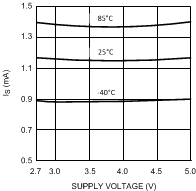
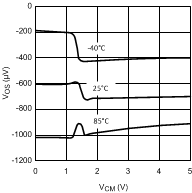
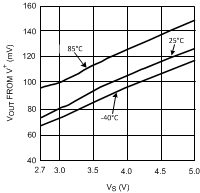
| RL = 600 Ω |
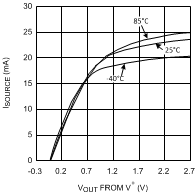
| VS = 2.7 V |
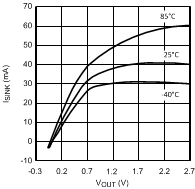
| VS = 2.7 V |
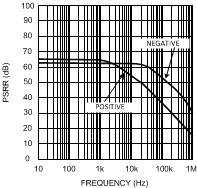
| VS = 2.7 V |
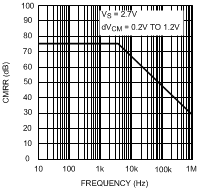
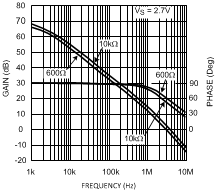
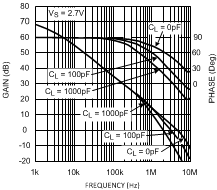
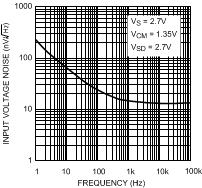
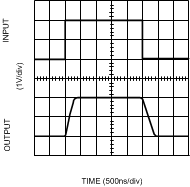
| VS = 2.7 V |
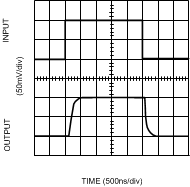
| VS = 2.7 V |
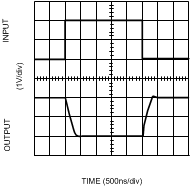
| VS = 2.7 V |
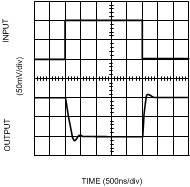
| VS = 2.7 V |
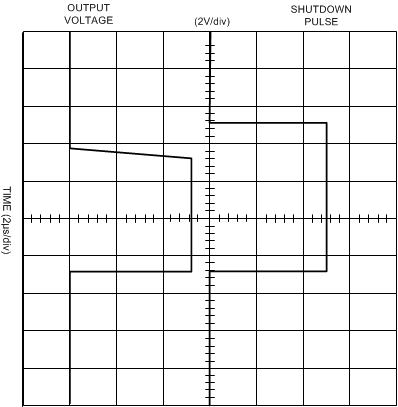
| VS = 5 V |
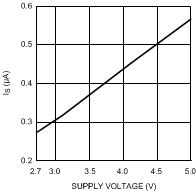
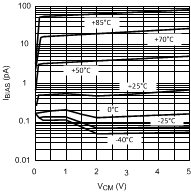
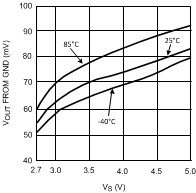
| RL = 600 Ω |
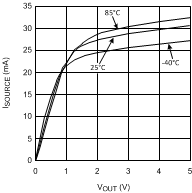
| VS = 5 V |
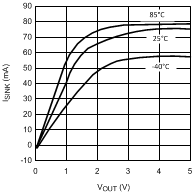
| VS = 5V |
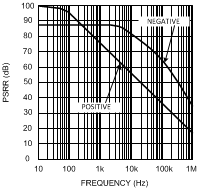
| VS = 5 V |
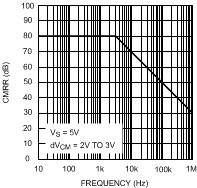
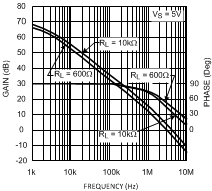
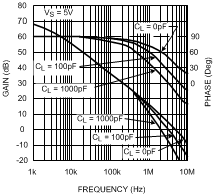
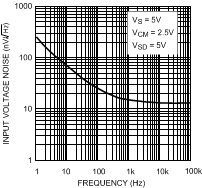
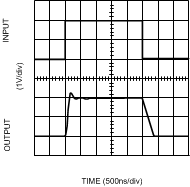
| VS = 5 V |
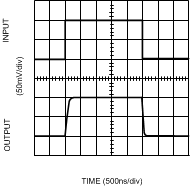
| VS = 5 V |
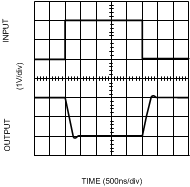
| VS = 5 V |
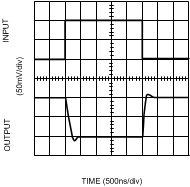
| VS = 5 V |
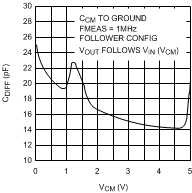
| VS = 5 V | |